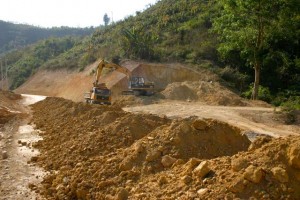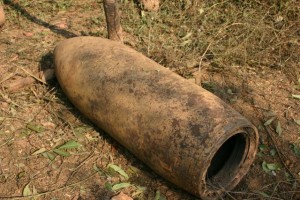Project Phongsali 2011: Road crews move soil about. Villagers find bombs and other ordnance.

Road crews are discovering bombs as they rebuild highway 2E through the southern districts of Phongsali. Sometimes villagers buy or spirit those bombs away to empty of explosives. We decided to focus our efforts this year on villages along this stretch of road.
Week Two
Day Eight
Today we headed out of Muang Khoua to investigate conditions in villages along the main east-west highway through the southern districts of Phongsali. For years this road has been not much more than an unpaved, single-lane trail winding alongside the Nam Ou River and its tributaries.
The road, now designated Route 2-E, is currently being widened, re-graded, and resurfaced. To fight the recurrent problem of washouts and landslides, the hillsides above and below are being cut and reshaped with massive terraces that will minimize erosion during the rainy season. In the future this highway will be an all-season road connecting trade centers in northern Viet Nam, like Dien Bien Phu, with towns in northern Laos and southern China.
In the first village we hit, Sop At, just five kilometers out of Muang Khoua, people described an unhealthy familiarity with unexploded ordnance. However, villagers were confident that they have already removed most of what they’ve found over the past forty years. Person after person shared tales of carrying rockets, mortars, and cluster bomblets from forest and field to the banks of the nearby river and gingerly throwing the deadly refuse into the water.
On the other hand, road crews have recently been moving hills about and uncovering previously unseen ordnance. In Sop At, young boys lead us to a 750-pound bomb that a power shovel uncovered while terracing; the boys’ fathers had carted the bomb home where they planned to harvest the explosives inside.

Villagers carted this bomb home and then experimented with different techniques before they successfully removed the back plate, giving them access to the valuable explosive within.
It didn’t take much detective work for us to reconstruct the steps that the men performed to get at what they considered the good stuff inside. Cuts, scrapes, dents and other scars on the casing documented the varied techniques and tools that the men employed. Clearly, false starts and frustration preceded success.
First, the men tried to saw the bomb in half. They expended a lot of elbow grease and, no doubt, dulled more than a few hacksaw blades before changing strategy. Ultimately, the men wrenched off the bomb’s back plate and rear fuse. Once the casing was open, they chiseled out hundreds of pounds of rock-hard explosive.
After finishing the job, the men probably congratulated themselves on how skillfully they had completed the task. They may have pondered why some people are fearful of bombs when their bomb yielded its contents without any indication of danger. They may have resolved to duplicate their techniques on future bombs. They might even have instructed their sons.
What the men didn’t know is that they lived through the job because their bomb, like most big bombs in Laos, had an electrical fuse long since gone dead. Should the men next encounter a device with a mechanical fuse, their rolling the bomb about, their hacking, sawing and hammering might trigger a detonation that would reduce the total substance of their being to little more than a faint pink mist.
(Note: “Big bomb” is a term of reference that we use to designate bombs ranging in size from 250 pounds to 3,000 pounds or more. During the war, the United States dropped over four million “big bombs” on Laos, a country that — at that time — had a population of less than three million people.)
By shining a flashlight into the mostly empty bomb, we discovered why the casing was still on hand and had not yet been sold for scrap. We saw that the bomb’s booster charge was still intact, as was its front fuse. With most of the bomb’s explosives removed, there was no longer a threat of it exploding, but should the relatively small charge inside the booster detonate, flames would blow-torch out of the open end, and metal fragments from the booster’s casing would discharge like a shotgun blast on steroids. (I visited a village last year and interviewed the parents of two teenagers when died when the youths tapped a similar booster with a shovel and it exploded).
By midday, after visiting several villages along this roadway, we resolved to make this locale the focus of our project. Destroying the booster inside the 750 will be one of our first projects. We’ll make the casing safe before someone further tampers with it, or a grass fire ignites the booster.
